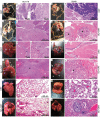Subcutaneous preconditioning increases invasion and metastatic dissemination in mouse colorectal cancer models
- PMID: 24487410
- PMCID: PMC3944498
- DOI: 10.1242/dmm.013995
Subcutaneous preconditioning increases invasion and metastatic dissemination in mouse colorectal cancer models
Abstract
Mouse colorectal cancer (CRC) models generated by orthotopic microinjection of human CRC cell lines reproduce the pattern of lymphatic, haematological and transcoelomic spread but generate low metastatic efficiency. Our aim was to develop a new strategy that could increase the metastatic efficiency of these models. We used subcutaneous implantation of the human CRC cell lines HCT116 or SW48 prior to their orthotopic microinjection in the cecum of nude mice (SC+ORT). This subcutaneous preconditioning significantly enhanced metastatic dissemination. In the HCT116 model it increased the number and size of metastatic foci in lymph nodes, lung, liver and peritoneum, whereas, in the SW48 model, it induced a shift from non-metastatic to metastatic. In both models the number of apoptotic bodies in the primary tumour in the SC+ORT group was significantly reduced compared with that in the direct orthotopic injection (ORT) group. Moreover, in HCT116 tumours the number of keratin-positive tumour buddings and single epithelial cells increased at the invasion front in SC+ORT mice. In the SW48 tumour model, we observed a trend towards a higher number of tumour buds and single cells in the SC+ORT group but this did not reach statistical significance. At a molecular level, the enhanced metastatic efficiency observed in the HCT116 SC+ORT model was associated with an increase in AKT activation, VEGF-A overexpression and downregulation of β1 integrin in primary tumour tissue, whereas, in SW48 SC+ORT mice, the level of expression of these proteins remained unchanged. In summary, subcutaneous preconditioning increased the metastatic dissemination of both orthotopic CRC models by increasing tumour cell survival and invasion at the tumour invasion front. This approach could be useful to simultaneously study the mechanisms of metastases and to evaluate anti-metastatic drugs against CRC.
Keywords: Collective invasion; Colorectal cancer model; Metastasis; Orthotopic injection; Single tumour cell; Subcutaneous preconditioning.
Figures




Similar articles
-
Higher metastatic efficiency of KRas G12V than KRas G13D in a colorectal cancer model.FASEB J. 2015 Feb;29(2):464-76. doi: 10.1096/fj.14-262303. Epub 2014 Oct 30. FASEB J. 2015. PMID: 25359494
-
A new EGFR and c-Met bispecific NIR-II fluorescent probe for visualising colorectal cancer and metastatic lymph nodes.EBioMedicine. 2025 May;115:105687. doi: 10.1016/j.ebiom.2025.105687. Epub 2025 Apr 17. EBioMedicine. 2025. PMID: 40250245 Free PMC article.
-
Vascular endothelial growth factor C disrupts the endothelial lymphatic barrier to promote colorectal cancer invasion.Gastroenterology. 2015 Jun;148(7):1438-51.e8. doi: 10.1053/j.gastro.2015.03.005. Epub 2015 Mar 6. Gastroenterology. 2015. PMID: 25754161
-
Apoptotic Janus-faced mycotoxins against thoracal and breast metastases.Apoptosis. 2023 Jun;28(5-6):754-768. doi: 10.1007/s10495-023-01837-1. Epub 2023 Apr 13. Apoptosis. 2023. PMID: 37055605 Free PMC article. Review.
-
Mouse models in oncogenesis and cancer therapy.Clin Transl Oncol. 2006 May;8(5):318-29. doi: 10.1007/s12094-006-0177-7. Clin Transl Oncol. 2006. PMID: 16760006 Review.
Cited by
-
Mouse models of colorectal cancer: Past, present and future perspectives.World J Gastroenterol. 2020 Apr 7;26(13):1394-1426. doi: 10.3748/wjg.v26.i13.1394. World J Gastroenterol. 2020. PMID: 32308343 Free PMC article. Review.
-
Biparatopic Protein Nanoparticles for the Precision Therapy of CXCR4+ Cancers.Cancers (Basel). 2021 Jun 11;13(12):2929. doi: 10.3390/cancers13122929. Cancers (Basel). 2021. PMID: 34208189 Free PMC article.
-
Development of orthotopic mouse models for mid-low rectal cancer.Acta Pharmacol Sin. 2025 Jun;46(6):1772-1781. doi: 10.1038/s41401-025-01489-8. Epub 2025 Feb 12. Acta Pharmacol Sin. 2025. PMID: 39939805
-
Selective depletion of metastatic stem cells as therapy for human colorectal cancer.EMBO Mol Med. 2018 Oct;10(10):e8772. doi: 10.15252/emmm.201708772. EMBO Mol Med. 2018. PMID: 30190334 Free PMC article.
-
Tumor models to assess immune response and tumor-microbiome interactions in colorectal cancer.Pharmacol Ther. 2022 Mar;231:107981. doi: 10.1016/j.pharmthera.2021.107981. Epub 2021 Sep 2. Pharmacol Ther. 2022. PMID: 34480964 Free PMC article. Review.
References
-
- Adell G. C., Zhang H., Evertsson S., Sun X. F., Stål O. H., Nordenskjöld B. A. (2001). Apoptosis in rectal carcinoma: prognosis and recurrence after preoperative radiotherapy. Cancer 91, 1870–1875 - PubMed
-
- Bacac M., Stamenkovic I. (2008). Metastatic cancer cell. Annu. Rev. Pathol. 3, 221–247 - PubMed
-
- Bendardaf R., Ristamäki R., Kujari H., Laine J., Lamlum H., Collan Y., Pyrhönen S. (2003). Apoptotic index and bcl-2 expression as prognostic factors in colorectal carcinoma. Oncology 64, 435–442 - PubMed
-
- Bosch R., Moreno M. J., Dieguez-Gonzalez R., Céspedes M. V., Gallardo A., Nomdedeu J., Pavón M. A., Espinosa I., Mangues M. A., Sierra J., et al. (2012). Subcutaneous passage increases cell aggressiveness in a xenograft model of diffuse large B cell lymphoma. Clin. Exp. Metastasis 29, 339–347 - PubMed
Publication types
MeSH terms
Substances
LinkOut - more resources
Full Text Sources
Other Literature Sources
Medical

